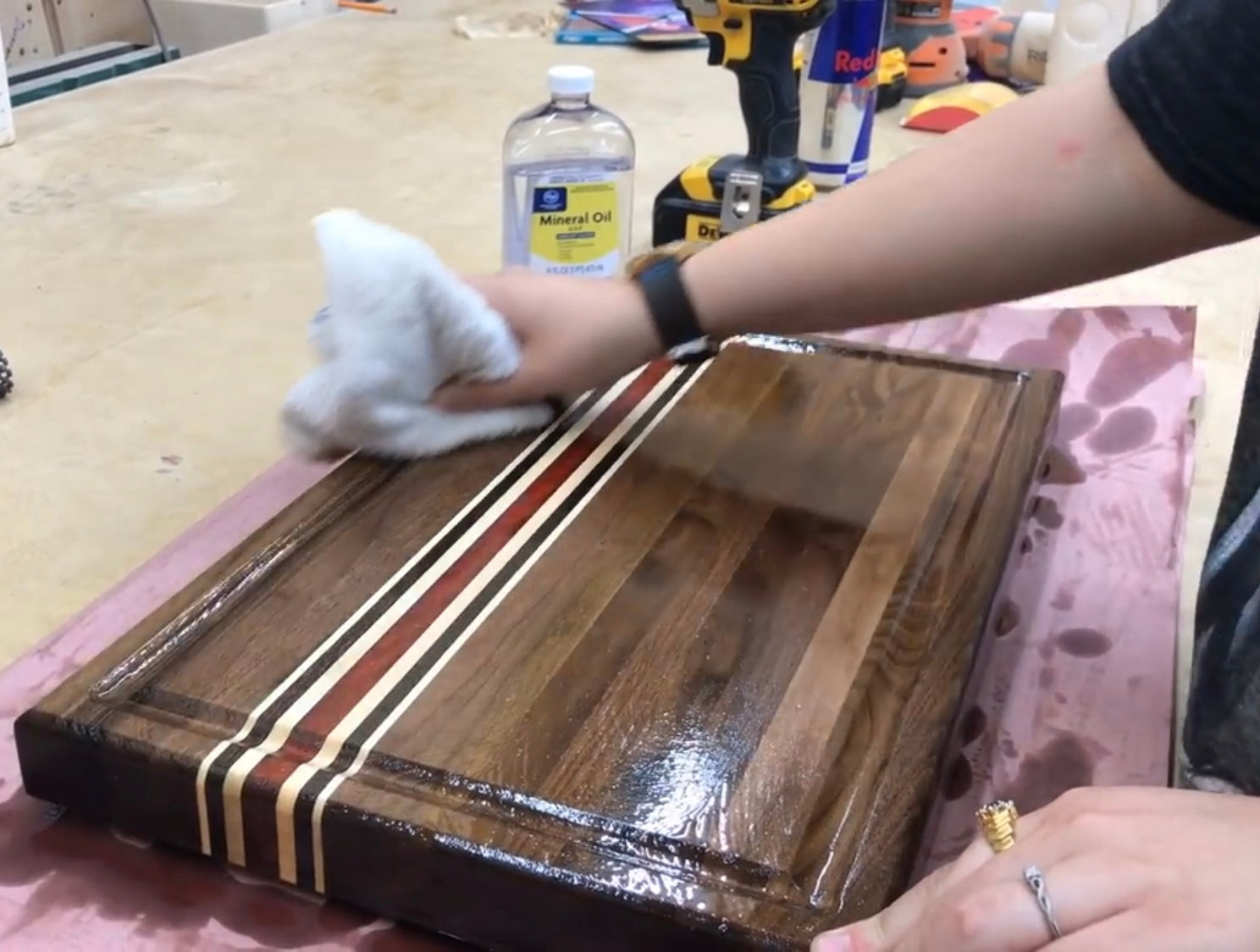The short answer is “Yes, if it’s the right oil, and you let it dry first.”
Here’s a detailed answer for those interested.
There are two general classes of oils. Drying Oils, and Non Drying Oils.
A Drying Oil is one that will harden to form a solid film after exposure to the air over time. The oil hardens through a chemical reaction called cross-linking, or polymerization by intaking oxygen. So in actuality they “cure” rather than dry. Just like a polyurethane.
Some examples of drying oils include tung oil, linseed oil, and walnut oil.
Note: Danish oil is not an oil per se. Rather, it is a combination of two things; a drying oil, and a varnish. There is no fixed formula for a Danish oil. Each manufacturer creates their own blend. And so can you. The guideline is that it’s typically 1/3 varnish, and 2/3 oil.
This combination is a drying/curing combination that will leave a hard film finish.
2nd Note: Varnish is not a specific product. (e.g. polyurethane, lacquer etc.) Varnish is the term used to talk about the appearance of a finished piece. For example; “that table has a nice varnish,” or “that table has a nice glossy hard finish.”
To be considered a varnish, the products used must be clear or translucent to let the wood grain show through. Paint is not a varnish.
A varnish (or varnished look) can be achieved with products or combinations of products that include polyurethanes, lacquers, epoxies, etc.
In short; you CAN apply a lacquer or a polyurethane over a Danish oil. Just as you can over any Drying Oil. The key to success is to make sure the oil has fully dried first. This should make sense, because once dried, the oil has cured to a hard solid film surface, and stuff will now stick to it.
The other general class of oils are Non Drying Oils. These are oils which will not polymerize & harden with exposure to oxygen. And they will stay “wet” or “oily” forever.
The Real Difference Between Drying & Non Drying:
Chemically speaking, (among other things), oils have long chains of carbon-carbon bonds. The bonds between these carbons are either double bonds, or single bonds. If all of the bonds are single, we say the compound is fully saturated. If some are double, we say it is unsaturated.
We can measure just how many double bonds there are. If there is a lot, we can say it is very unsaturated.
In organic chemistry, we can assign a measure to the compound designating just how many single bonds there are vs double bonds. And we can calculate the degree of unsaturation. For oils we typically do this by reacting iodine with it. The more iodine that reacts means the more unsaturated it was.
A compound with a high iodine number has a lot of unsaturation, and is therefore a drying oil.
A compound with a low iodine number has a low unsaturation and is therefore a non drying oil.
The guideline is this:
Oils with an iodine number of less than 115 are considered non drying.
And oils with an iodine number greater than that are considered drying.
Some examples:
Tung oil - 163-173 - Drying
Walnut oil - 120-155 - Drying
Linseed oil - 136-178 - Drying
Mineral oil - 0 - Non Drying
Coconut oil - 7-10 - Non Drying
Palm oil - 16-19 - Non Drying
A table of some values:
https://en.m.wikipedia.org/wiki/Iodine_value
In summation, just make sure the oil you applied to your piece was a drying oil. Then make sure that it has had the time to fully dry/cure (days to weeks depending on heat & humidity). After that, feel free to add a top coat of lacquer or polyurethane to it.
In contrast. If you used a non drying oil, such as mineral oil, your piece will not take a topcoat of lacquer or polyurethane in the future, no matter how long you wait.
Finally, if you don’t know if the oil you used was a drying oil or not, just look up the iodine value on a table. Anything over 115 is a drying oil.


Can I Apply Lacquer or Polyurethane Over an Oil Finish?
Comments (47)
http://mewkid.net/when-is-xuxlya3/ – Amoxicillin Online Amoxicillin Online jox.hjps.kingsfinewoodworking.com.moh.et http://mewkid.net/when-is-xuxlya3/
http://mewkid.net/when-is-xuxlya3/ – Amoxicillin Online Buy Amoxicillin Online frz.onjd.kingsfinewoodworking.com.euf.sw http://mewkid.net/when-is-xuxlya3/
Hi. I have applied linseed oil two coats dried over 4 days for a table top. I want to ensure it is spillage and hot drink water rings free. Also alcohol. Is it better to finish with wax or add a Polyurethane coat to it for longevity. My clients will be using it rigourously
I’ve finished many kitchens with Watco Danish oil and added lacquer for a final surface. We are in Arizona, which is a very dry and warm climate and generally the material has been ready within 24 hours for lacquer. I would assume in cooler or wet climates that would need to be extended at least another day or two. I have work that I completed over forty years ago with this method and it still looks great.
I’ve finished many kitchens with Watco Danish oil and added lacquer for a final surface. We are in Arizona, which is a very dry and warm climate and generally the material has been ready within 24 hours for lacquer. I would assume in cooler or wet climates that would need to be extended at least another day or two. I have work that I completed over forty years ago with this method and it still looks great.
I have a kitchen type table – the top is made from antique pine from a Victorian linen cupboard by a furniture renovator. He added four reproductive chunky turned legs to finish the table which is now about 20 years old.
Unfortunately it has ‘ink like’ black stains which he said it gave it character.
I’d like to sand it down and give it a Danish oil finish but he finished it with a heavy coat of wax.
I know that I must remove this wax if my sander is going to be effective so I’d be grateful for some ideas on how to remove this wax finish which I think was a bad choice.
I have a mid century walnut coffee table and I sanded it, applied teak oil and don’t like the finish. Can I add a polyurethane cover to it now Or do I need to sand and start over?
Hello, We are building wooden boxes and sand them down with 220 grit aluminum oxide paper and then put a coat of Watco Danish Oil on them and dry overnight. the next day the wood is still very smooth but then we put a coat of polyurathane over the Danish Oil and after it dries the surface is very rough and needs more sanding. Is there a product that can be applied over the Danish Oil without turning out rough and would not require more sanding? I would appreciate your expert advice.
Thank You
Carl
Over the past few days I have been refinishing a cedar chest. I was reading the directions on the polyurethane I was planning to use and saw that I needed to use mineral spirits over the surface before applying it, but accidentally put mineral oil in it. Thankfully I caught myself before applying the polyurethane. I have seen lots of conflicting information out there, but am I right that it is NOT advisable to put an oil based polyurethane over mineral oil that I have put on it? Should I just wait until the mineral oil seems to be dried out (6-12 months) or would it be better to work it out using a solvent such as naphtha, acetone, or mineral spirits?
I applied Cannabis oil on my oak wood slice to prevent it from cracking during the drying process. I used A LOT OF IT! After 2 weeks, I don’t know what came to my mind; I applied Old English lemon oil on my oak slices. I don’t know if it will dry, or I have to live with an oily surface. Before I use glossy polyurethane over the two different types of oils, I want to ask, can I ?
I’m using fresh rosewood for commercial restaurant tables. How many coats of Danish oil can I apply before topping it up with Lacquer. And any advise on sanding. Thanks
I would think this would be useful when you want that deep, hand rubbed finish you get from an oil, but also want some protection from water spots or rings. Using this method on a mesquite domino table. Also have done this on a mesquite bar top.
I build guitars and have been using Tru oilon them,? can I use a polyurethane on after it is dry and hard.
Bookmarked ! Right infront of my face after I commented on another article . Must say, website has a new daily reader and fan:)
I have been using Watco Cherry oil on Cherry and Watco Teak oil on Teak, after about 5 to 7 coats it looks fantastic. Yes you need to let it dry between coats, and I also lightly sand with 320 before the last coat.
Can you give me an example of when you would want to do this? Thank You, The description is very thorough.
Make a mandolin